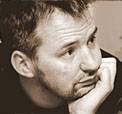Around, 460 B.C. Greek philosopher, Democritus, asked: If you divide a piece of matter in half and then in half again, how many breaks will you have to make until you can break it no further? He concluded that everything was made of various arrangements of atoms or átomos, "the smallest indivisible particle of matter" or something that cannot be divided.
Naturally this idea was ignored - partly because Aristotle, who was very good at selling ideas, dismissed it - and partly because Democritus didn't write his ideas down.
And so it remained until the early 19th Century, when an English chemist, John Dalton, showed that (broadly) everything was made of atoms. Then, in 1897, the physicist, J.J. Thompson described an atomic structure complete with a nucleus of protons and neutrons surrounded by constantly moving electrons.
And so it turned out that Democritus had been right all along. Everything and everyone are made up of atoms which behave in very different ways depending on how they are combined. Including, of course, the blueprint for life, DNA - deoxyribonucleic acid - arranged in the now-famous double helix molecule composed of two ribbons with a backbone of alternating sugar and phosphate residues, which is then connected by rungs of hydrogen bonds and four bases.
The point here is not the chemistry but the notion that life, evolution, innovation can only ever rearrange what already exists. Mice and elephants, sharks and penguins, the blue whale and the flea, the chimpanzee and man, all share the same atomic composition - the same stuff - but their dramatic diversity in weight, size, colour, texture, and behaviour come about because of microscopic differences in their DNA.
Even between humans, who of course share DNA, we find differences that we would all agree are significant. Part of this is down to differences not in DNA itself but in the combinations of DNA in the two sets of chromosomes gifted to us by our parents.
So the component parts of Robert Pershing Wadlow, the world's tallest man at eight feet 11 inches, and Nelson Aquino de la Rosa, one of the world's shortest at 20 inches, are the same. They are just organised differently.
Early man observed the benefits of naturally occurring forest fires and learned to control it perhaps 1.8 million years ago. By 3,500 BC, the old idea of fire was added to fallen tree trunks to create a new idea - log canoes.
Around 4000 BC in Mesopotamia (what is now Iraq, Syria, and Iran) the old idea of log canoes was added to flat potters wheels and wild horses to create a new idea - the horse-drawn cart.
In 1672, Ferdinand Verbiest, a member of a Jesuit mission in China, added the old idea of carts to another old idea, steam power, to create a new idea - the first automobile, albeit a toy for the son of the Kangxi Emperor. And at 4:17:42 p.m. Eastern Daylight Time, July 20, 1969 the old ideas of ships, fireworks, and science fiction were added together to enable the first landing on the moon.
The difference in success between individual lives, or companies, relies not on creating something from nothing, but in combining existing ideas and materials. At its best this process meets existing needs with new ideas or even creates new needs from old ideas.
In 1955, Walt Disney combined three old ideas - the fairytale, notably those collected by the Brothers Grimm; animation, developed from stop motion techniques discovered accidentally by French filmmaker Georges Méliès; and the ornamental garden, something dating back to Ancient Egyptian and to Arabian pleasure gardens. Together, they combined to produce a new idea - the Theme Park.
More recently, Nintendo took the old idea of Kokeshi, traditional Japanese wooden dolls, and developed software that lets you create digital avatars - uncannily accurate cartoon characters (Miis) of yourself, friends and family who become characters in Mii-oriented games. The result is a kind of 'virtual family' play room.
New art, literature, and music are constantly recycled from existing works. William Shakespeare started with traditional dramatic structures and often borrowed his themes. (Romeo and Juliet came from a poem by Arthur Brooke and was retold in prose by William Painter). He adapted the language of the street as well inventing at least 1,700 new words of his own, not to mention a swath of new dramatic techniques.
In her Harry Potter books, J.K. Rowling takes a little bit of Enid Blyton's naughtiest school girl, a dollop of C.S. Lewis's Narnia, Jill Murphy's The Worst Witch at School, and Dicken's Oliver Twist. She prefers to avoid discussion of influences, yet they are there - the raw materials, literary atoms and molecules with which she has created the Hogwarts universe.
Elsewhere, mash-up, bootleg, smash-up, blend, or bastard pop combines the music from one song with the singing from another. Ideally, as Wikipedia puts it, "the music and vocals belong to completely different styles/genres generally considered to be incompatible, yet skilfully and artfully combined into a pleasurably euphonic hybrid" as with the R&B vocal of Destiny's Child singing 'Bootylicious' being mixed over the grunge band guitar of Nirvana's 'Smells Like Teen Spirit' to produce the Mashup classic "Smells Like Booty".
Understanding that everything new is made from something old and studying how what we enjoy is the result of this new-for-old mash-up allows us all to do the same.
Nature has mixed and remixed matter to arrive at our current universe. Mankind has mixed and remixed ideas to arrive at our current global society. And it is to new combinations of old ideas that we must look to for innovation - to make our lives better.


I agree that a lot of ideas and inventions are a source of inspiration for newer ideas. That's why it's really important to research first and make sure your new idea/invention hasn't already been patented yet. I recommend using www.WikiPatents.com.
Good luck with your new ideas!
Hello Max,
Steve Jobs says that his motto, justifying imitation, was itself taken from Picasso who wrote: 'Good artists copy; great artists steal. Genius is the art of hiding your sources.' Perhaps all that is 'new' is, in reality, most always some type of collaboration